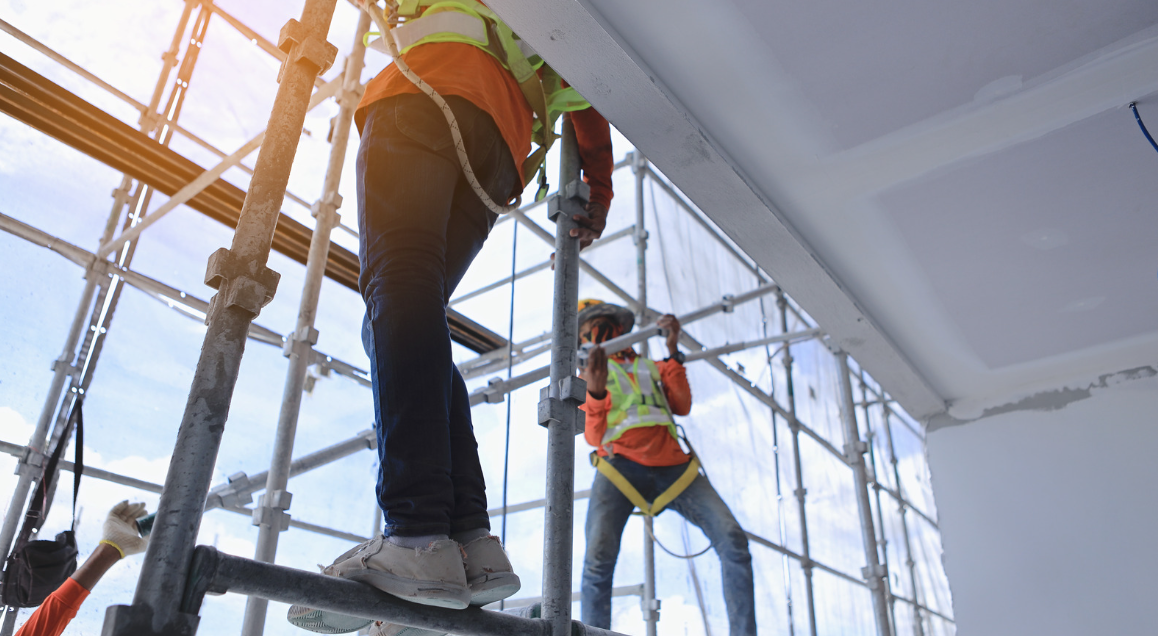
A Scaffolding Guide for Painting Projects in Milwaukee, WI
Posted on September 12, 2023
As a painter, scaffolding is essential to make your job easier and safer. However, choosing the right type of scaffolding can be daunting, especially if you need to familiarize yourself with the different types available. We’ve created this scaffolding buyer’s guide to help you decide when purchasing equipment. In this guide, we will explore the different types of scaffolding, safety considerations, and other factors you should consider when choosing scaffolding for your painting projects.
What Is Scaffolding?
Scaffolding is a temporary structure made of metal or wood used to support workers and materials during construction, repair, and painting. It allows people to work at heights safely without risking their lives. Scaffoldings are typically erected using poles, planks, ladders, and other components that can be assembled on-site.
Types of Scaffolding:
Several types of scaffolding are available, and each type has unique features that make it suitable for different types of painting projects. Here are the most common types of scaffolding that painters use:
H-frame scaffolds: They are popular for painters because they are lightweight, versatile, and easy to assemble. These are typically made of aluminum or steel and are ideal for indoor painting projects with limited space.
Walk-through scaffolds: Walk-through scaffolds are similar to H-frame scaffolds, but they feature a walk-through design that allows painters to move around the scaffold easily. These are ideal for larger indoor painting projects with more hanging space.
Mobile scaffolds: Mobile scaffolds are designed with wheels, allowing painters to move them around easily. These are best used for outdoor painting projects where painters must keep up with the work.
Aerial lifts: Aerial lifts are large, hydraulic lifts that allow painters to work at heights safely. These are ideal for large outdoor painting projects where painters must reach high spaces.
Safety Considerations:
Safety is always a top priority when using scaffolding equipment. Here are some safety considerations that painters should keep in mind:
Follow manufacturer instructions: Always follow the manufacturer’s instructions when assembling scaffolding equipment. Failure to do so can result in unsafe working conditions.
Use the right equipment for the job: Make sure you choose scaffolding equipment suitable for the type of painting project you are working on.
Inspect the equipment before use: Inspect it carefully for defects or damage before using scaffolding equipment.
Use personal protective equipment: Wear appropriate protective equipment, such as hard hats and non-slip shoes, when using scaffolding equipment.
Other Factors to Consider:
In addition to the type of scaffolding and safety considerations, there are other factors that painters should consider when purchasing scaffolding equipment. These include:
Height requirements: Make sure you choose scaffolding equipment that can reach the height you need to work at.
Weight limits: Be aware of the weight limit for your chosen scaffolding equipment. This will prevent overloading the equipment, which can cause accidents.
Portability: Consider the portability of the scaffolding equipment you choose, especially if you need to move it around your workspace.
Safety Tips
Painting can be hazardous, and scaffolding accidents are common. Ensure to follow these safety tips when using scaffolding:
- Always use safety belts while working on scaffolding, regardless of the height.
- Ensure the scaffolding is stable and level, with no loose parts.
- Only use scaffolding that meets the relevant safety standards.
- Never overload the scaffolding with more weight than it can handle.
Seek Professional Help
As a painter, you can benefit from the expertise of professional scaffolding companies. They can advise on the best type of scaffolding, install, and dismantle it after the painting project is complete. Professional scaffolding companies also provide additional safety equipment and training to ensure a safe working environment.
Frequently Asked Questions
Q: What is the best type of scaffolding for painting?
A: The best type of scaffolding for painting depends on the size and scope of your project. If you’re working on an indoor project with limited space, then H-frame scaffolds are a good option. Walk-throughs or mobile scaffolds would be more appropriate for larger projects or outdoor painting jobs.
Q: How do I know if a scaffold is safe to use?
A: Before using any scaffolding, inspect it carefully for defects or damage. Ensure all components are in good condition and that there are no loose parts. Additionally, always ensure that the weight limit for the scaffolding is not exceeded and that you are using the correct equipment for the job. Finally, follow manufacturer instructions carefully and use personal protective equipment when working on a scaffold.
Q: How often should I inspect my scaffolding?
A: You should inspect your scaffolding before each use and after any changes or repairs. Additionally, periodic equipment inspections should be conducted at least every three months to ensure it is in good condition.
Conclusion:
In conclusion, purchasing scaffolding equipment can be tricky, but it doesn’t have to be. By keeping the different types of scaffolding, safety considerations, and other factors in mind, you can make an informed decision when choosing scaffolding for your painting projects. Safety is always the top priority, so follow manufacturer instructions, choose the right equipment for the job, and use personal protective equipment. With the right scaffolding equipment, you can make your painting projects easier, more efficient, and safer. If you need help with a painting project, contact us to set up a free estimate appointment.





